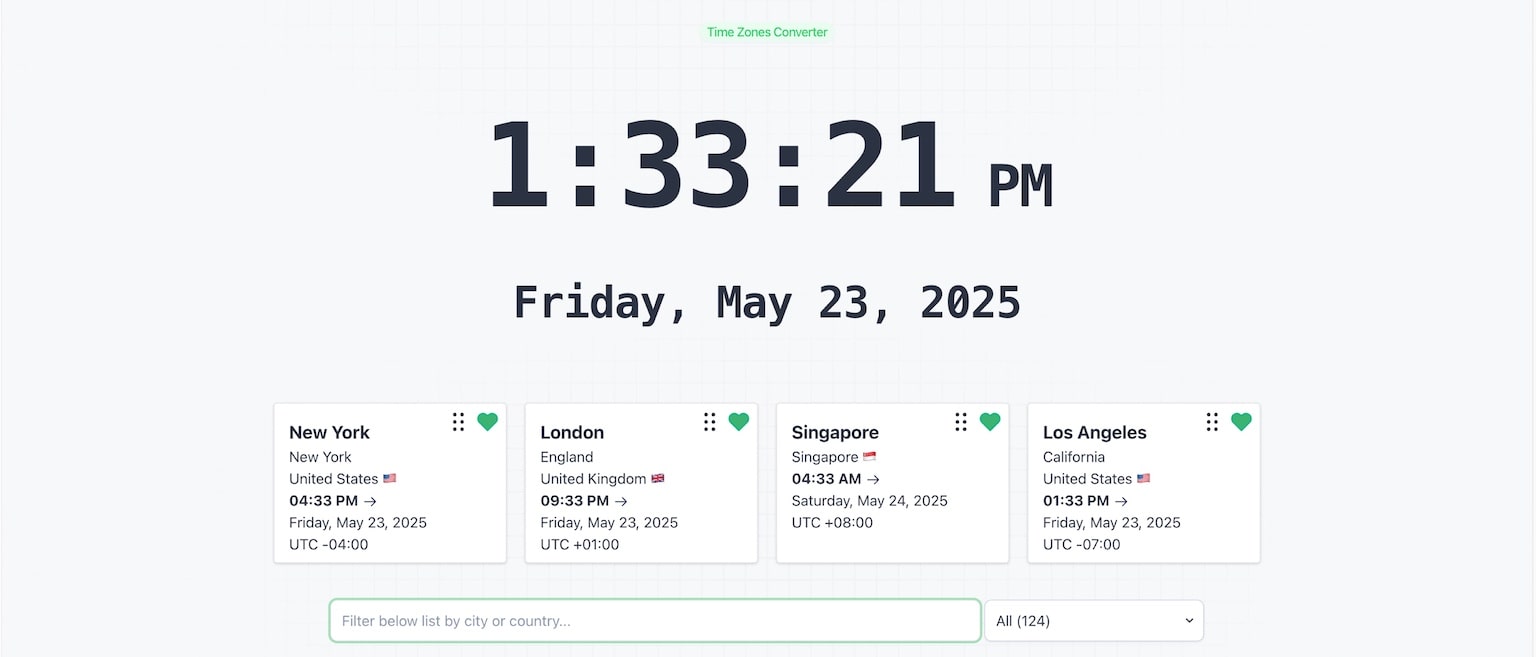Mastering Time Zones for Seamless Remote Work
« Back to all blog postsEffectively manage international teams and projects by understanding time differences. Learn strategies and tools for seamless remote collaboration.

The proliferation of remote work has fundamentally altered traditional collaboration methods, making geographical boundaries less significant. This global shift enables teams to connect and work together from different continents, fostering diverse perspectives and talent pools.
However, navigating varied remote work time zones introduces distinct daily challenges that can affect workflow and communication. Developing a strong understanding of time zone management is therefore essential for maintaining productivity, ensuring smooth project progression, and fostering team cohesion in a remote setting.
The Global Shift and Your Workday
The move towards remote work isn’t just a trend; it’s a fundamental reshaping of how we approach our professional lives. The once-rigid concept of a nine-to-five workday, synchronized across an entire office, has given way to something far more fluid. For many, the workday now bends and stretches across remote work time zones, tailored to individual needs and team distribution.
This flexibility opens doors to incredible opportunities, such as tapping into a worldwide talent pool, allowing companies to assemble dream teams irrespective of location. Yet, this same advantage introduces complexities when trying to manage global teams. Adapting to these new rhythms is no longer a niche skill but a core competency for anyone participating in modern work environments.
It’s about more than just knowing what time it is elsewhere; it’s about rethinking collaboration itself. Luckily, Alarm Clock Tab provides an easy time zone manager you can use to keep an eye on times in other geographic locations.

Hurdles in a Multi-Time Zone Environment
Working across different time zones presents more than just arithmetic challenges; it introduces genuine operational hurdles. These aren’t minor inconveniences but significant factors that can impact team performance and well being if not addressed proactively. The dream of a globally connected team can quickly sour if the practicalities of remote work time zones are ignored.
Communication Bottlenecks
When team members are hours apart, a simple question that might be resolved in minutes in a co-located office can take an entire day. This delay, often referred to as “time zone tax,” can significantly slow project velocity. Imagine a developer in Tokyo waiting for feedback from a colleague in London; the workday overlap might be minimal, leading to frustrating stalls in progress. Critical updates can get stuck, and momentum is easily lost.
Meeting Scheduling Dilemmas
Finding a meeting time that doesn’t require someone to be up at dawn or burning the midnight oil is a constant puzzle. It’s more than just an inconvenience; it raises questions of fairness and can lead to meeting fatigue. If the same individuals consistently have to adjust to extreme hours, resentment can build, and participation quality can drop. The challenge is to find equitable solutions that respect everyone’s personal time.
Risk of Team Member Burnout
The pressure to be constantly available is a significant risk in multi-time zone teams. Team members might feel compelled to check messages late at night or early in the morning to keep up or show commitment. This “always-on” culture, driven by the fear of missing out or delaying others, is a fast track to burnout, eroding both productivity and morale. A study by a team of Microsoft researchers, published in the Harvard Business Review, found that teams spread across many time zones can experience a significant drop in shared understanding and an increase in coordination challenges, which can contribute to this pressure.
Potential for Miscoordination
Asynchronous work is a cornerstone of effective global collaboration, but without careful management, it can lead to miscoordination. Decisions might be made, or work might proceed based on incomplete information because not everyone was “in the room” or online at the same time. This can lead to team members feeling excluded or out of sync, impacting cohesion and potentially leading to duplicated efforts or misaligned outcomes.

Practical Approaches to Time Zone Harmony
While the hurdles of working across remote work time zones are significant, they are not insurmountable. With thoughtful strategies, teams can transform these challenges into strengths, fostering a more flexible and inclusive work environment.
The key is to move beyond simply acknowledging time differences to actively designing workflows that accommodate them. This is crucial to effectively manage global teams and ensure smooth time zone coordination.
- Defining Core Collaboration Windows: Identify a few hours each day where the majority of the team’s workdays overlap. These “golden hours” should be reserved for essential synchronous tasks like critical discussions, decision making, or collaborative problem solving. This doesn’t mean everyone must be online for eight hours simultaneously, but rather a focused period for high-bandwidth interaction. For instance, a team spread from California to Germany might find a two-hour window from 8 AM PST (5 PM CET) works for vital check-ins.
- Optimizing Asynchronous Communication: Master asynchronous communication strategies. This means detailed, context-rich updates, clear documentation of decisions, and leveraging shared documents or project management tools so team members can catch up and contribute effectively regardless of when they log on. Instead of quick, fragmented messages, encourage comprehensive handovers. Individuals can also use timers to boost focus and beat procrastination when working through these asynchronous updates during their personal work blocks.
- Equitable Meeting Scheduling: Implement fair international scheduling tips. This often involves rotating meeting times so the inconvenience is shared. If a meeting has to happen outside standard hours for some, ensure it’s not always the same people making the sacrifice. Consider if a meeting is truly necessary or if the objective can be achieved asynchronously.
- Enhancing Time Zone Visibility: Make it easy for everyone to see who is working when. Shared calendars displaying local times, status messages indicating availability (e.g., “Focusing until 2 PM CET” or “Offline – EOD”), or team dashboards with current times and availability can significantly reduce guesswork and prevent accidental interruptions during someone’s off-hours.
These approaches require consistent effort and a willingness to adapt, but they lay the groundwork for a truly global and productive team.
Leveraging Technology for Time Zone Management
Beyond strategies and cultural shifts, the right technology plays a vital role in simplifying the complexities of remote work time zones. Digital tools can automate, clarify, and streamline many of the logistical challenges, making time zone coordination far more manageable. For instance, a quick check using an online time zone converter online can prevent a scheduling mishap that might otherwise disrupt a colleague’s evening. Many teams already use calendar apps that support multiple time zones, but exploring dedicated tools can further enhance efficiency. Project management software often includes features to visualize global schedules, helping managers allocate tasks with awareness of local working hours. Even simple digital aids like an online timer or stopwatch can help individuals structure their work blocks effectively around team availability. For those needing to quickly find out the current time in different cities or use a comprehensive time zone converter tool, numerous online resources are readily available.
| Tool Type | Key Features for Time Zones | Primary Benefit | Impact on Time Zone Coordination |
|---|---|---|---|
| Calendar Applications (e.g., Google Calendar, Outlook Calendar) | Display multiple time zones, meeting scheduling assistance, shared availability | Prevents scheduling errors, clarifies meeting times for all | Simplifies finding mutually convenient slots, reduces confusion |
| Dedicated Time Zone Converters | Quickly convert times between multiple locations, world clock views | Accurate, on-the-fly time checks for calls and deadlines | Ensures precise international scheduling tips and communication timing |
| Project Management Software (e.g., Asana, Trello, Jira with plugins) | Visual team schedules, task assignment with time awareness, deadline tracking across zones | Centralized view of global team capacity and progress | Improves project planning and resource allocation across time zones |
| Communication Platforms (e.g., Slack, Microsoft Teams) | Status updates reflecting local times, presence indicators, scheduled messages | Facilitates timely asynchronous communication strategies and awareness of availability | Enhances responsiveness and understanding of team members’ work patterns |

Cultivating a Time-Zone-Aware Team Culture
While tools and strategies are essential, the true lubricant for smooth global collaboration is a team culture steeped in empathy and awareness. To effectively manage global teams, leaders must actively cultivate an environment where time zone differences are not just tolerated but understood and respected. This goes beyond simply knowing where people are; it’s about internalizing how their location impacts their workday and interaction patterns. As an article in the Harvard Business Review highlights, fostering psychological safety is paramount in diverse, distributed teams, allowing members to openly discuss scheduling challenges without fear of negative repercussions.
- Promote empathy regarding varied schedules: Encourage team members to consider their colleagues’ local realities. A simple “Good morning/afternoon/evening” acknowledges this.
- Set clear expectations for asynchronous response times: This is a core part of effective asynchronous communication strategies. Define what a reasonable turnaround time is, so no one feels pressured to be online 24/7.
- Encourage robust documentation and knowledge sharing: Make information accessible so team members can find answers independently, reducing reliance on immediate responses across time zones.
- Recognize and respect local holidays and cultural events: Being mindful of these dates shows respect and helps in planning. Using a comprehensive holiday calendar resource can be invaluable for keeping track of different regional observances.
Building this culture takes conscious effort and consistent reinforcement from leadership, but it’s the foundation upon which successful global teams are built.
Sustaining Effective Global Collaboration
Mastering remote work time zones is not a one-time setup but an ongoing process of refinement and adaptation. As teams evolve, projects shift, and new members join from different parts of the world, the strategies for managing time differences must also be flexible.
Regularly review your team’s time zone strategies: what worked six months ago might need adjustment. Solicit team feedback actively.
Are the core collaboration hours still effective? Are communication protocols clear and respected?
The importance of clear communication protocols cannot be overstated; they are the bedrock of successful distributed work. Ultimately, thriving in a global, remote environment hinges on a collective mindset of flexibility, supported by adaptable tools and processes. Continuous learning and adjustment are key to long-term success and productivity.